Tschamberhöhle
Tschamber Cave
Useful Information
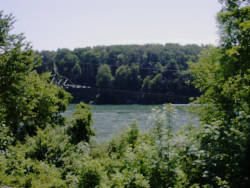

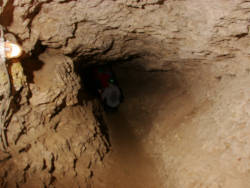
| Location: |
Brombachstr. 4, 79618 Rheinfelden (Baden).
In Karsau-Riedmatt, 5 km NE Rheinfelden, between the B34 and the railway. Car park at the end of Riedmatt in the direction of Rheinfelden. (47.5888909, 7.8191885) |
| Open: |
18-APR to OCT Sun, Hol 10-14. [2025] |
| Fee: |
Adults EUR 5.50, Children (6-14) EUR 3.50, Children (3-5) free. [2025] |
| Classification: |
 Karst Cave Karst Cave
 river cave,
Muschelkalk river cave,
Muschelkalk
|
| Light: |
 Incandescent Incandescent
|
| Dimension: | L=1,550 m. |
| Guided tours: | L=1,000 m. |
| Photography: | allowed |
| Accessibility: | no |
| Bibliography: |
Rudolf Steiner (2004):
Die „Tschamberhöhle“ bei Rheinfelden-Riedmatt. Zur Herkunft ihres Namens.
In: Das Markgräflerland, Band 1/2004, S. 78–87.
 online
online
Rudolf Steiner: Die Tschamberhöhle bei Rheinfelden-Riedmatt – ein Mythos wird entzaubert. In: Vom Jura zum Schwarzwald. 79. Jahrgang, 2005, S. 145–157.  online
online
Serge von Bubnoff (1910): Die Tschamberhöhle bei Riedmatt am Dinkelberg In: Mitteilungen des Badischen Landesvereins für Naturkunde. Band 5 (1905–1910), Nr. 251–300. Freiburg i. Br., S. 376–380.  pdf
pdf
|
| Address: |
Tourist-Information, Karl-Fürstenberg-Straße 14, D-79618 Rheinfelden (Baden), Tel: +49-7623-966-87-20.
E-mail: |
| As far as we know this information was accurate when it was published (see years in brackets), but may have changed since then. Please check rates and details directly with the companies in question if you need more recent info. |
|
History
| 1839 | first written mention. |
| 1856 | entrance buried during construction of the Hochrhein railway from Basel to Singen. |
| 1859 | Tschamberloch dubbed a stalactite cave. |
| 1876 bis 1879 | search for the cave by drilling holes remains unsuccessful. |
| 1890 | opened as a show cave. |
| 1954 | opened to the public. |
| 1966 | electric light. |
| 2009 | Geo-Museum Dinkelberg opened. |
| 2018 | taken over by WST Rheinfelden (Baden). |
Description
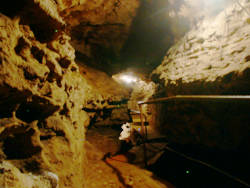
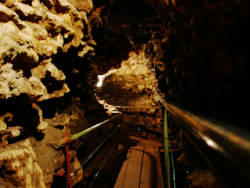
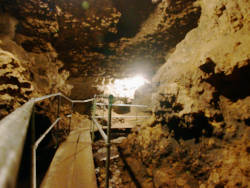

The Tschamberhöhle (Tschamber Cave) is exceptional in several respects. First, there is its location: the entrance to the cave is directly above the Rhine. This is particularly complicated at this point because here at Riedmatt, just a few metres from the banks of the Rhine, the ascent into the Black Forest begins. This narrow strip was needed for the construction of the B34 (E54) and the railway line. The original cave entrance was therefore filled in during the construction of the Basel-Schaffhausen railway line. The new artificial entrance is located in the narrow strip between the railway line and the federal highway. Access is quite adventurous: you park in Riedmatt and then walk to the federal highway, which you have to cross carefully. Then there is a narrow path between the guardrail and the fence, which leads about 70 m along the road to the cave entrance. There is also a second path, but it is somewhat hidden and considerably longer. Opposite the Hotel Storchen, at Brombachstr. 4, you walk around the house and down the footpath to the Sägebächle. The path follows this brook under the highway, and then you walk between the road and the railway line to the cave entrance.
Another special feature is that the Tschamberhöhle is an active water cave. There are only two show caves with streams in Germany. The underground stream that flows through it empties into the Rhine a little further on. The cave river vanishes about 100 m from the entrance, you can see how the stream disappears into a siphon. The karst spring is 40 m closer to the Rhine, and after just 5 m, this small tributary flows into the Rhine. However, a side effect is that the cave can be flooded after heavy rainfall, making it impossible to visit.
Finally, it is a cave in Muschelkalk (Upper Triassic), which is another special feature, as there are only three show caves in Germany located in this layer. The geological situation is also quite unusual. Muschelkalk is actually found deep underground, but here, directly on the southern rim of the Black Forest, the rocks were pulled upwards in a staircase formation by the uplift of the Black Forest. And so, the closer each step is to the Black Forest, the higher it was lifted. The result is a narrow strip of karstified Muschelkalk on the southern edge of the Black Forest called Dinkelberg. The exhibition on the geology of the Dinkelberg at Brombachstr. 2 named Geo-Museum Dinkelberg is dedicated to this geological feature. The municipal geological museum houses a permanent exhibition with over 100 fossils, crystals and rocks from the region. It is an excellent addition to a visit to the show cave. Unfortunately, it seems to be closed at the moment.
The cave has been developed to a length of about 500 m, with the path following the main passage along the cave stream, which is crossed several times by bridges. As an active water cave, it naturally has few stalactites, but it does have gorge-like passages with typical wall and ceiling formations created by the erosion of the flowing water. The guided tour ends at a 5-metre-high waterfall. Once you have reached the end, you have to return the same way, which has the advantage that you can admire the cave from both directions. One should not underestimate how much the view can differ. In the rear part of the cave, after the viewing area, there are several siphons that can only be navigated by experienced cave divers. After a 300-metre-long siphon followed by an approx. 100 to 150 m long dry section, there is a final siphon. This is the current end point of the cave and has so far been dived by Axel Gnädinger to a length of 90 m. The cave is approximately 1,550 m long in total.
Until a few years ago, the Tschamberhöhle was maintained by the Schwarzwaldverein (Black Forest Association), Karsau-Riedmatt local group. Like many associations today, this one is struggling with declining membership, and the cave is now operated by Tourism Rheinfelden (Baden). Visitors are provided with helmets. There is no real reason for this, it is probably to get visitors in the right mood for the cave. In fact, the cave has some relatively low places. However, it is not unusual for a show cave to have to stoop for a short time.
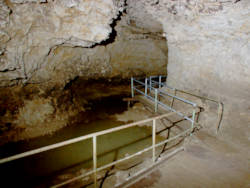
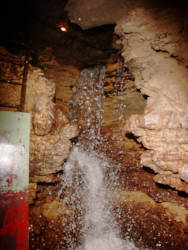
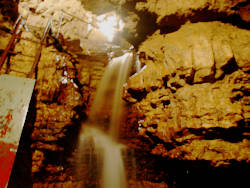
 Search DuckDuckGo for "Tschamberhöhle"
Search DuckDuckGo for "Tschamberhöhle" Google Earth Placemark
Google Earth Placemark OpenStreetMap
OpenStreetMap Tschamberhöhle
Tschamberhöhle  Tschamberhöhle, official websitee
Tschamberhöhle, official websitee  Index
Index Topics
Topics Hierarchical
Hierarchical Countries
Countries Maps
Maps